One of the conditions for a comfortable life in a country house is the proper and uninterrupted operation of the sewer system. And if the old cast-iron pipes with time could give cracks and leak, then when using modern polymer, this problem faded into the background. But even new pipes can be clogged if they were installed incorrectly, so when installing you need to know what the slope of the sewer should be at 1 meter in a private house.

Why is the slope
In order for the water flow in the sewage system to wash out solid particles behind it, pipes should be laid under a slope. In this case, the angle of inclination of the sewage must comply with the norms established by the SNiP. But in pursuit of installation speed or using labor of unskilled workers, you can get a sewer system made with serious mistakes:
-
Ignoring the established norms, do not make a slope at all or the angle of the sewage is quite small. Thus, the movement of the effluent will be excessively slow and solid particles will begin to form in the pipes. Very quickly, this will lead to the need to clean the entire sewer system, because if you install the toilet and the pipe slope is not done, then there will be almost no flushing and feces will begin to decompose right in the pipes, spreading the smell throughout the house.
-
The angle of the sewer pipe is made too large. In this case, the drains through the pipes will move too quickly, washing the solid particles, but not taking them with them. This fact will again lead to clogged pipes, which will have to be cleaned regularly.
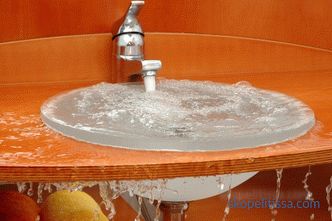
Do not neglect the norms established in the SNiP because they were determined on the basis of calculations and observations over the years.
Proper sewage slope
For those who do not know how the data in SNiP documents are deciphered, it should be borne in mind that all norms are indicated in the form of fractions. For example, the inscription 0.03 and 0.008 is read as follows: a pipe, one meter in length from one end, rises by three centimeters, from the other one is raised only by eight millimeters. If the figure is only one, then one end of the pipe is at the zero mark, and the other is raised to a predetermined height.
Since the sewer pipeline is much longer than a meter, a formula is used to measure the slope, where the upper end of the pipe is determined as follows: based on the norms, for example, three centimeters of slope are taken per meter, which are multiplied by the entire length of the pipe . As a result, it will be determined how far the upper end of the pipeline should be raised.
With a pipe length of 25 meters, the calculation looks like this: 3 * 25 = 75. That is, the slope of the sewer pipe should have 75 centimeters from one edge.

As the sewage system is laid not only in the house, but also its limits, the slope is maintained throughout the pipe. At the same time, it is determined depending on the diameter of the pipes - the smaller it is, the greater the slope. There are cases when it is impossible to comply with the rules, in this case small deviations are allowed. But it should be taken into account that in this case everything must be carefully calculated so that there is no trouble with the sewage system.
On our website you can find contacts of construction companies that offer the service of designing and installing sewage and water supply. Directly to communicate with representatives, you can visit the exhibition of houses "Low-rise Country".
What to do in the case when it is impossible to withstand the desired inclination
There are cases when installation encounters difficulties, leading to the fact that the angle of inclination of the sewerage is significantly different from the permissible norms. In this case, the following measures are taken:
If the calculations show that deviation from the given norms is possible, then lay the pipes, but at the same time make additional tees at some distance, through which the pipes will be cleaned.
When laying the pipe still adhere to the recommendations, but in difficult areas to establish elevation differences, which are organized at the expense of additional wells. With this solution it will be possible to install the pipe at the right angle. Such a well can be one or several, but correct calculations and installation guarantee proper operation of the sewage system.
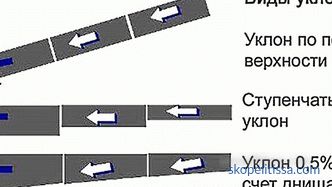
As a last resort, if there is no way you can withstand the desired slope and calculations show that sewage operation by gravity is impossible, then you have to use a fecal pump.This device can be installed both on the local sewer branch, and for the entire system.
When laying plastic pipes, you can be sure that they will need to be cleaned much less frequently than cast-iron pipes, since the smooth inner surface of the walls ensures the sliding of solids.
Withstand the angle
To determine the angle of inclination of the sewer pipe is only half the battle. The main difficulty is to withstand it during installation, for which a special level with a goniometer is used.

If for some reason the protractor does not work, but knowledgeable masters can withstand the desired slope and using the usual level. To do this, there are several methods, and for each of them you need to do a little preparation:
-
A slanting line is drawn on the wall, corresponding to the chosen slope. A level is applied to it and a mark is placed on it in the region of the air bubble. After that, the pipe is set in accordance with the location of the bubble. The method is not very reliable, as it allows a certain error.
-
With the use of the meter level a special lining is applied that will correspond to the angle of inclination.
An example of using a "modified" level in a video:
This might be interesting! In the article on the following link read about the sewage of concrete rings.
Preparation for work
Before proceeding with the installation of the sewer system, you will need to prepare the following tools and materials:
-
plastic pipes that have a cross section of 5 and 10 centimeters;
-
elements that will be used to connect the pipes;
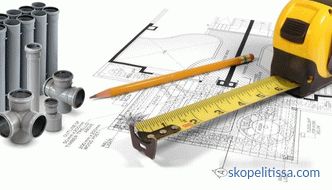
-
cuffs for sealing joints;
-
glue that is intended for bonding plastic;
-
marker, tape measure, level and saw;
-
cement.
If the sewage system is not made new, but a reconstruction is made of the existing one, then before proceeding with the installation, you need to study the old structure, or take a picture of it. After that, you need to make a plan for installing the new system:
-
a drawing is drawn on the millimeter paper, which displays all the points of wiring, the bathrooms, the distances and the riser are marked;
it is checked that the new plan coincides with the already existing sewer system;
-
then calculations are made and the amount of material needed is determined.
On our site you can find contacts of construction companies that offer the service of reconstruction and rebuilding of houses. Directly to communicate with representatives, you can visit the exhibition of houses "Low-rise Country".
How to choose pipes
When choosing pipes it is necessary to pay attention to their color - the sewer is painted gray. A different diameter of the section suggests that each type is designed to perform individual functions.
If an existing sewage system is reconstructed and there were no complaints about the work, then the easiest way to compare the diameter of old pipes with new ones is that the errors are practically excluded.

In addition, during installation, you need to take into account which household appliances will be connect to the system. To drain the water from the dishwasher and washing machine will be enough in diameter of 2.5 centimeters, for the bathroom and shower will need 3.5 centimeters. In general, pipes are no more than 5 centimeters in diameter throughout the house, but for the riser you will need to purchase a pipe with a cross section of 11 centimeters.
In order not to buy extra materials or make miscalculations, it is best to measure old pipes and make a corresponding purchase. In addition, in accordance with the old design, the same number of connecting elements is bought.
This may be interesting! In the article on the following link read about the drainage system and storm sewers on the site.
Performance of work
After all the preparatory work has been completed, you can proceed directly to installation. First of all, you need to disassemble the old system. The works are carried out as follows:
-
First, problem areas are identified in which additional work will have to be carried out. This may be the place where the pipe passes through the wall.
-
The chisel starts dismantling the cast-iron pipes with the help of a chisel. At the same time it is impossible to allow hit of cast iron to the main highway of sewer system. Otherwise, it may fail in its work.
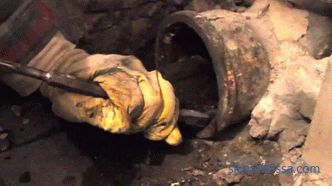
-
If replacement of the main riser is not expected, then the pipe is sawn off from it using a grinder.
After dismantling has been carried out, work is stopped until the connecting nodes are completely cooled.
Installation of modern plastic pipes can be done in two ways.
Installation of plastic pipes with glue
-
pipes are cut into pieces of the required length;
-
edges are cleaned with emery paper;
-
degrease edges;
-
pipes are checked for compatibility;
-
glue is applied in the right places;
-
the processed elements are interconnected;
-
when two pipes are compressed, a roller is formed that resembles liquid honey in color;
-
glue dries within an hour.
Installation of plastic pipes by welding
-
installation also begins with cutting pipes of the desired length and stripping;
-
the soldering device heats up to a temperature not lower than 260 degrees;
-
the connectors and the pipe are fixed on the soldering iron;
-
the parts are heated to the required temperatures;
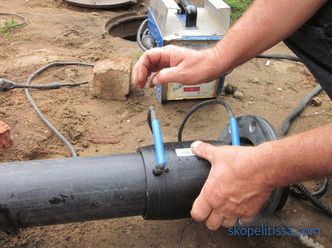
-
pipes are connected in heated places;
-
seams are checked for integrity.
It may be interesting! In the article on the following link read about the well for storm sewers.
Important points for installation
It is important to begin the installation of the sewer system from the upper points. Thus, it will be much easier to maintain the desired slope. At the same time the sockets should be located against the flow of wastewater. Throughout the execution of all work is controlled by the angle of inclination of sewer pipes. This is done either by using a level or marks on the wall.
Since the old sewage system is made of cast-iron pipes, it is natural that modern plastic pipes will in some places be joined with old cast-iron ones. For this purpose, special fittings are used, with the help of which a plastic pipe is inserted into a section of a cast-iron pipe in an upright position.
When installing the sewer system, it is most important to pay attention to the areas where the pipe lying in a horizontal position is connected to a vertical stand. In this case, you cannot make this connection at an angle of 90 degrees. For the system to work perfectly and no turbulence forces arise during the water flow, two transitions are made in the form of knees which are in an inclined position at an angle of 45 degrees.
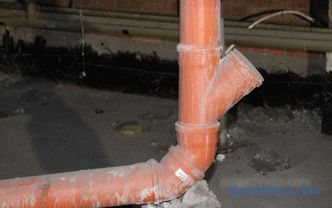
Clearly about the nuances of designing and installing sewerage in the country See the following video in the house:
It might be interesting! In the article on the following link read about the sewage system for a private house.
Conclusion
At first glance, the installation of sewer pipes is quite simple. But without the availability of relevant knowledge and experience, the desired result and the correct operation of the entire system are not guaranteed. If you know how to correctly calculate the angle of inclination of the sewage system and maintain it during installation, then the whole system will work reliably and without failures.



